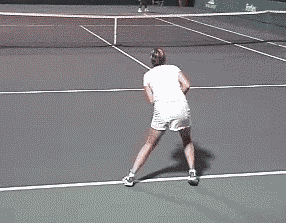|
TennisOne Lessons Ways of the Game – Speed Merchants or the First Strike Jim McLennan I remember Ion Tiriac, world renown coach and tennis expert (he partnered Ilie Nastase in Romanian Davis Cup, coached Guillermo Vilas then Boris Becker then Henri LeConte) when asked the most important thing in tennis, he replied, “Put the ball over the net.” Not much more than that to the game of tennis. Put the ball over the net and then it becomes the opponent's problem.
As I observe players out our club either working on their games, or playing in league matches, no matter what their level of play, no matter what strides they have made in developing their games, no matter their level of tactical sophistication or lack thereof, it always seems to be about errors. Errors either throughout a set, or errors at critical times. The same holds true in professional tennis. As we enjoy the first week of the US Open, or work on our own games “back home” the winning is about error reduction, about simply making one less mistake than the other guy or gal.
When the hitter moves forward they find more potential angle of play, when the hitter moves back behind the baseline they reduce their potential angle of play. Meaning one can create a nifty angle when volleying, but generally when behind the baseline it is next to impossible to angle the ball away from the opponent.
These players move extremely well, and compete by virtue of their tenacity to get to the ball and recover quickly. They create pressure with their consistency, and from the belief they instill in an opponent's mind that they are not going to go away. As to time and angle, these players are content to often play well behind the baseline, managing their ball speed to maximize their own recovery time. Further, from behind the baseline they eschew angles for simply keeping the ball deep. Opposite the rabbit, is the player seeking to make the “first strike,” land the first punch, attempt to seize the offense as early as possible in the point. Ivan Lendl with a big serve and huge forehand, dominated opponents who could not consistently and accurately return his serve, and even Mac often struggled (later in his career) when he could not avoid Lendl's forehand. Similarly Roddick takes control of the point with a big serve and similarly big forehand.
And Lindsay Davenport, perhaps the current queen of the first strike game, uses her big serve and huge groundstrokes to seize control and dominate opponents. The key here is how quickly she gets an opponent out of position and on the run, in this way her own poor movement and lack of court speed becomes difficult to exploit. Agassi has played first strike tennis for many years, but his style has evolved. As regards time and angle, early in his career he appeared to play inside the baseline and favor brute power to the corners. Now he is more inclined to play inside the baseline and work the angles, controlling the point yet at the same time prolonging the punishment. And interestingly, this change in style has grown hand in hand with Agassi's commitment to fitness and by extension his improved movement about the court. This highlights the two versions of first strike tennis from the baseline, that is a player can move inside the baseline to control with power or with angle (or in the case of Federer and Nadal they often do both with the same shot). And if not from the baseline, one can play first strike tennis at the net with the serve and volley, and though it is less evident these days, it was not too long ago that Sampras and Navratilova dominated with their version of the first strike model. The first strike style favors risk over safety, making something happen instead of waiting for something to happen, looking for the opportunities that occur when the opponent hits short, and reducing the opponent's time and increasing your own angle of play. If you are looking to increase your first strike capabilities, here are a few areas to explore. When serving, experiment with a wide side spin in the deuce court, and a wide kick in the ad court. If you serve more flat than with spin, these wide serves can still be employed (only to less effect). If the serve lands suitably wide and the opponent recovers poorly (which happens all the time as I see it) you can now drive the ball to the open court, he/she is on the run and you are in control. As a receiver, the absolute best time to make the “first strike” is on the return of the second serve. You can move well inside the baseline and experiment with punishing down the line approaches, nifty cross court drives, or devilish backspin drop shots.
The fun for a spectator is to observe the ebb and flow of tactics throughout a match. The player who is losing because of errors may resort to defense to get back into the match. Conversely, a player who is losing but not making errors may resort to more offense to change the tenor of the match. Similar to the boxing analogy where a counter puncher (read rabbit) waits for an opening which may occur if the opponent takes a big swing (read first striker) but misses, on court a risk of going for a big shot is that it may actually open the court for the defense minded opponent. And certainly one can see the ebb and flow of movement and hitting, offense and defense, retrieving and the first strike throughout a match. Your comments are welcome. Let us know what you think about Jim McLennan's article by emailing us here at TennisOne.
|
||||||||||||



